Toshihisa Tanaka
Parameter-Efficient Fine-Tuning of 3D DDPM for MRI Image Generation Using Tensor Networks
Jul 24, 2025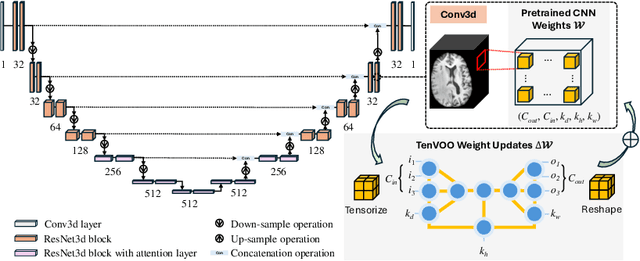



Abstract:We address the challenge of parameter-efficient fine-tuning (PEFT) for three-dimensional (3D) U-Net-based denoising diffusion probabilistic models (DDPMs) in magnetic resonance imaging (MRI) image generation. Despite its practical significance, research on parameter-efficient representations of 3D convolution operations remains limited. To bridge this gap, we propose Tensor Volumetric Operator (TenVOO), a novel PEFT method specifically designed for fine-tuning DDPMs with 3D convolutional backbones. Leveraging tensor network modeling, TenVOO represents 3D convolution kernels with lower-dimensional tensors, effectively capturing complex spatial dependencies during fine-tuning with few parameters. We evaluate TenVOO on three downstream brain MRI datasets-ADNI, PPMI, and BraTS2021-by fine-tuning a DDPM pretrained on 59,830 T1-weighted brain MRI scans from the UK Biobank. Our results demonstrate that TenVOO achieves state-of-the-art performance in multi-scale structural similarity index measure (MS-SSIM), outperforming existing approaches in capturing spatial dependencies while requiring only 0.3% of the trainable parameters of the original model. Our code is available at: https://github.com/xiaovhua/tenvoo
MR-EEGWaveNet: Multiresolutional EEGWaveNet for Seizure Detection from Long EEG Recordings
May 23, 2025Abstract:Feature engineering for generalized seizure detection models remains a significant challenge. Recently proposed models show variable performance depending on the training data and remain ineffective at accurately distinguishing artifacts from seizure data. In this study, we propose a novel end-to-end model, ''Multiresolutional EEGWaveNet (MR-EEGWaveNet),'' which efficiently distinguishes seizure events from background electroencephalogram (EEG) and artifacts/noise by capturing both temporal dependencies across different time frames and spatial relationships between channels. The model has three modules: convolution, feature extraction, and predictor. The convolution module extracts features through depth-wise and spatio-temporal convolution. The feature extraction module individually reduces the feature dimension extracted from EEG segments and their sub-segments. Subsequently, the extracted features are concatenated into a single vector for classification using a fully connected classifier called the predictor module. In addition, an anomaly score-based post-classification processing technique was introduced to reduce the false-positive rates of the model. Experimental results were reported and analyzed using different parameter settings and datasets (Siena (public) and Juntendo (private)). The proposed MR-EEGWaveNet significantly outperformed the conventional non-multiresolution approach, improving the F1 scores from 0.177 to 0.336 on Siena and 0.327 to 0.488 on Juntendo, with precision gains of 15.9% and 20.62%, respectively.
Mirror Descent and Novel Exponentiated Gradient Algorithms Using Trace-Form Entropies and Deformed Logarithms
Mar 11, 2025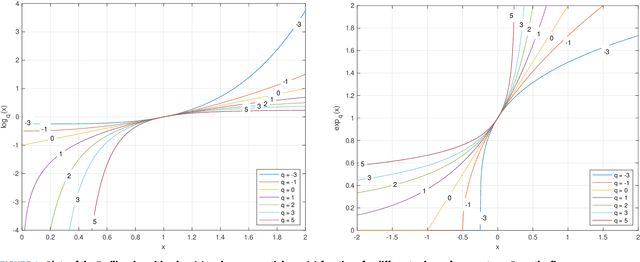
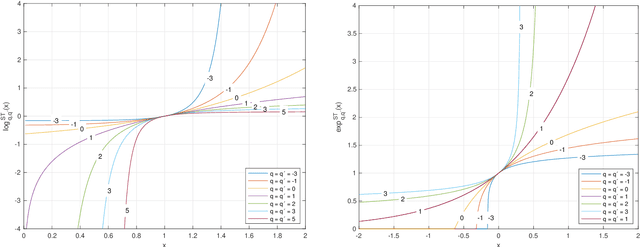
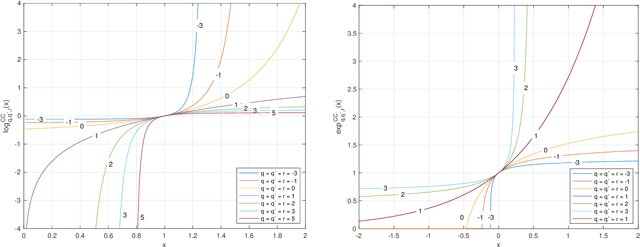
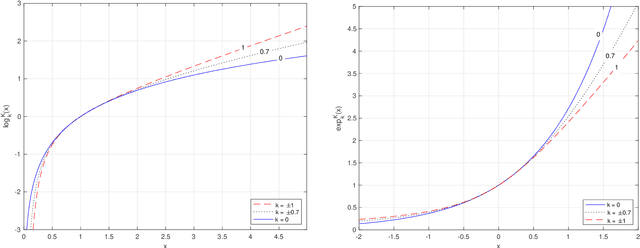
Abstract:In this paper we propose and investigate a wide class of Mirror Descent updates (MD) and associated novel Generalized Exponentiated Gradient (GEG) algorithms by exploiting various trace-form entropies and associated deformed logarithms and their inverses - deformed (generalized) exponential functions. The proposed algorithms can be considered as extension of entropic MD and generalization of multiplicative updates. In the literature, there exist nowadays over fifty mathematically well defined generalized entropies, so impossible to exploit all of them in one research paper. So we focus on a few selected most popular entropies and associated logarithms like the Tsallis, Kaniadakis and Sharma-Taneja-Mittal and some of their extension like Tempesta or Kaniadakis-Scarfone entropies. The shape and properties of the deformed logarithms and their inverses are tuned by one or more hyperparameters. By learning these hyperparameters, we can adapt to distribution of training data, which can be designed to the specific geometry of the optimization problem, leading to potentially faster convergence and better performance. The using generalized entropies and associated deformed logarithms in the Bregman divergence, used as a regularization term, provides some new insight into exponentiated gradient descent updates.
Model-Free Adversarial Purification via Coarse-To-Fine Tensor Network Representation
Feb 25, 2025Abstract:Deep neural networks are known to be vulnerable to well-designed adversarial attacks. Although numerous defense strategies have been proposed, many are tailored to the specific attacks or tasks and often fail to generalize across diverse scenarios. In this paper, we propose Tensor Network Purification (TNP), a novel model-free adversarial purification method by a specially designed tensor network decomposition algorithm. TNP depends neither on the pre-trained generative model nor the specific dataset, resulting in strong robustness across diverse adversarial scenarios. To this end, the key challenge lies in relaxing Gaussian-noise assumptions of classical decompositions and accommodating the unknown distribution of adversarial perturbations. Unlike the low-rank representation of classical decompositions, TNP aims to reconstruct the unobserved clean examples from an adversarial example. Specifically, TNP leverages progressive downsampling and introduces a novel adversarial optimization objective to address the challenge of minimizing reconstruction error but without inadvertently restoring adversarial perturbations. Extensive experiments conducted on CIFAR-10, CIFAR-100, and ImageNet demonstrate that our method generalizes effectively across various norm threats, attack types, and tasks, providing a versatile and promising adversarial purification technique.
Scalable Bayesian Tensor Ring Factorization for Multiway Data Analysis
Dec 04, 2024Abstract:Tensor decompositions play a crucial role in numerous applications related to multi-way data analysis. By employing a Bayesian framework with sparsity-inducing priors, Bayesian Tensor Ring (BTR) factorization offers probabilistic estimates and an effective approach for automatically adapting the tensor ring rank during the learning process. However, previous BTR method employs an Automatic Relevance Determination (ARD) prior, which can lead to sub-optimal solutions. Besides, it solely focuses on continuous data, whereas many applications involve discrete data. More importantly, it relies on the Coordinate-Ascent Variational Inference (CAVI) algorithm, which is inadequate for handling large tensors with extensive observations. These limitations greatly limit its application scales and scopes, making it suitable only for small-scale problems, such as image/video completion. To address these issues, we propose a novel BTR model that incorporates a nonparametric Multiplicative Gamma Process (MGP) prior, known for its superior accuracy in identifying latent structures. To handle discrete data, we introduce the P\'olya-Gamma augmentation for closed-form updates. Furthermore, we develop an efficient Gibbs sampler for consistent posterior simulation, which reduces the computational complexity of previous VI algorithm by two orders, and an online EM algorithm that is scalable to extremely large tensors. To showcase the advantages of our model, we conduct extensive experiments on both simulation data and real-world applications.
Generalized Exponentiated Gradient Algorithms and Their Application to On-Line Portfolio Selection
Jun 02, 2024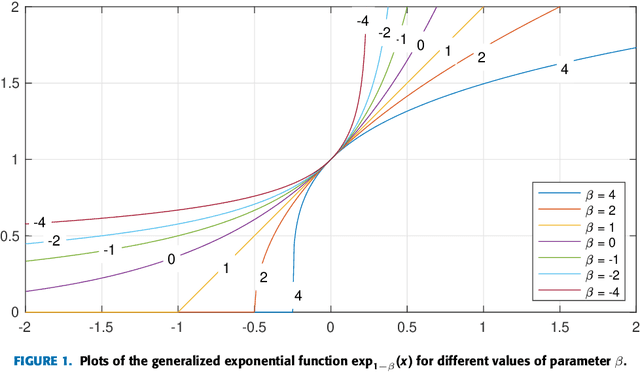

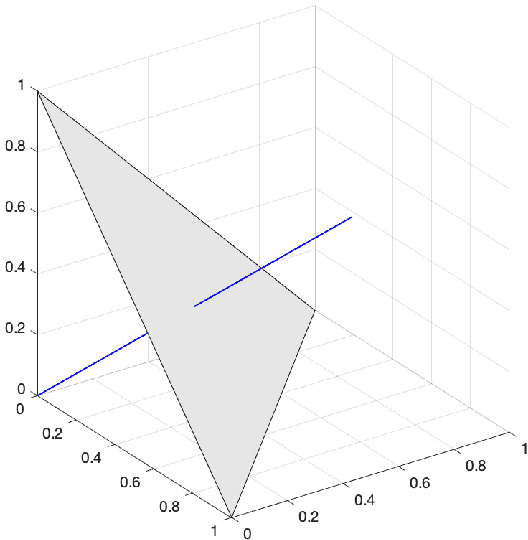
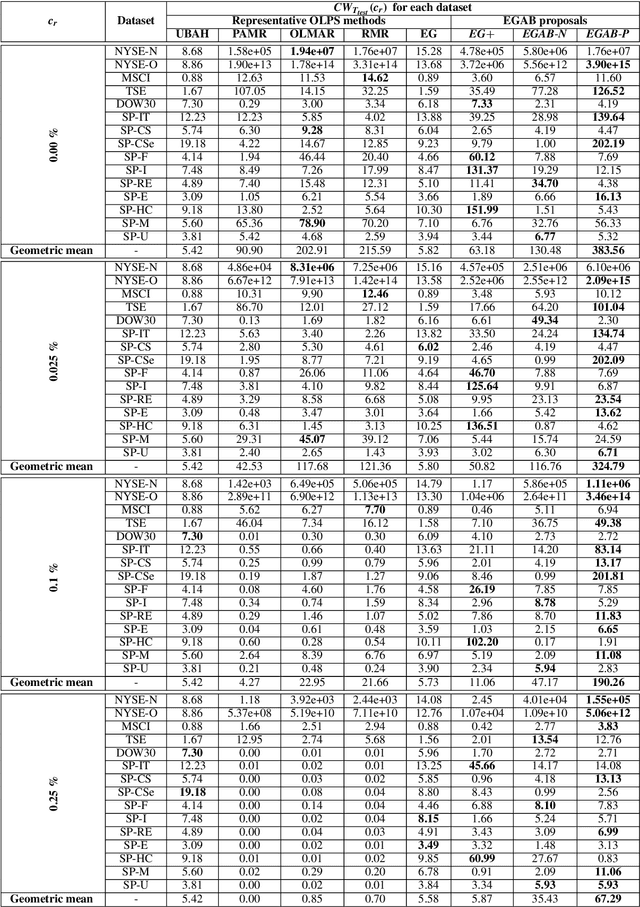
Abstract:This paper introduces a novel family of generalized exponentiated gradient (EG) updates derived from an Alpha-Beta divergence regularization function. Collectively referred to as EGAB, the proposed updates belong to the category of multiplicative gradient algorithms for positive data and demonstrate considerable flexibility by controlling iteration behavior and performance through three hyperparameters: $\alpha$, $\beta$, and the learning rate $\eta$. To enforce a unit $l_1$ norm constraint for nonnegative weight vectors within generalized EGAB algorithms, we develop two slightly distinct approaches. One method exploits scale-invariant loss functions, while the other relies on gradient projections onto the feasible domain. As an illustration of their applicability, we evaluate the proposed updates in addressing the online portfolio selection problem (OLPS) using gradient-based methods. Here, they not only offer a unified perspective on the search directions of various OLPS algorithms (including the standard exponentiated gradient and diverse mean-reversion strategies), but also facilitate smooth interpolation and extension of these updates due to the flexibility in hyperparameter selection. Simulation results confirm that the adaptability of these generalized gradient updates can effectively enhance the performance for some portfolios, particularly in scenarios involving transaction costs.
MAProtoNet: A Multi-scale Attentive Interpretable Prototypical Part Network for 3D Magnetic Resonance Imaging Brain Tumor Classification
Apr 13, 2024Abstract:Automated diagnosis with artificial intelligence has emerged as a promising area in the realm of medical imaging, while the interpretability of the introduced deep neural networks still remains an urgent concern. Although contemporary works, such as XProtoNet and MProtoNet, has sought to design interpretable prediction models for the issue, the localization precision of their resulting attribution maps can be further improved. To this end, we propose a Multi-scale Attentive Prototypical part Network, termed MAProtoNet, to provide more precise maps for attribution. Specifically, we introduce a concise multi-scale module to merge attentive features from quadruplet attention layers, and produces attribution maps. The proposed quadruplet attention layers can enhance the existing online class activation mapping loss via capturing interactions between the spatial and channel dimension, while the multi-scale module then fuses both fine-grained and coarse-grained information for precise maps generation. We also apply a novel multi-scale mapping loss for supervision on the proposed multi-scale module. Compared to existing interpretable prototypical part networks in medical imaging, MAProtoNet can achieve state-of-the-art performance in localization on brain tumor segmentation (BraTS) datasets, resulting in approximately 4% overall improvement on activation precision score (with a best score of 85.8%), without using additional annotated labels of segmentation. Our code will be released in https://github.com/TUAT-Novice/maprotonet.
Robust Diffusion Models for Adversarial Purification
Mar 24, 2024Abstract:Diffusion models (DMs) based adversarial purification (AP) has shown to be the most powerful alternative to adversarial training (AT). However, these methods neglect the fact that pre-trained diffusion models themselves are not robust to adversarial attacks as well. Additionally, the diffusion process can easily destroy semantic information and generate a high quality image but totally different from the original input image after the reverse process, leading to degraded standard accuracy. To overcome these issues, a natural idea is to harness adversarial training strategy to retrain or fine-tune the pre-trained diffusion model, which is computationally prohibitive. We propose a novel robust reverse process with adversarial guidance, which is independent of given pre-trained DMs and avoids retraining or fine-tuning the DMs. This robust guidance can not only ensure to generate purified examples retaining more semantic content but also mitigate the accuracy-robustness trade-off of DMs for the first time, which also provides DM-based AP an efficient adaptive ability to new attacks. Extensive experiments are conducted to demonstrate that our method achieves the state-of-the-art results and exhibits generalization against different attacks.
Adversarial Training on Purification (AToP): Advancing Both Robustness and Generalization
Jan 29, 2024

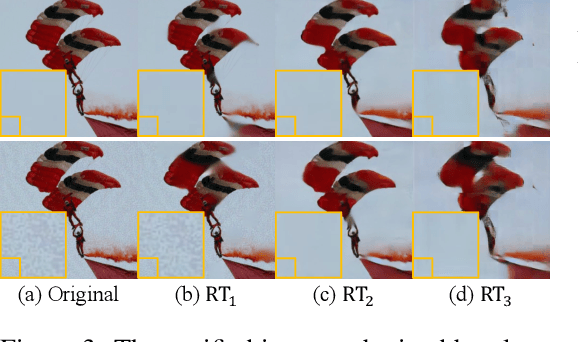

Abstract:The deep neural networks are known to be vulnerable to well-designed adversarial attacks. The most successful defense technique based on adversarial training (AT) can achieve optimal robustness against particular attacks but cannot generalize well to unseen attacks. Another effective defense technique based on adversarial purification (AP) can enhance generalization but cannot achieve optimal robustness. Meanwhile, both methods share one common limitation on the degraded standard accuracy. To mitigate these issues, we propose a novel framework called Adversarial Training on Purification (AToP), which comprises two components: perturbation destruction by random transforms (RT) and purifier model fine-tuned (FT) by adversarial loss. RT is essential to avoid overlearning to known attacks resulting in the robustness generalization to unseen attacks and FT is essential for the improvement of robustness. To evaluate our method in an efficient and scalable way, we conduct extensive experiments on CIFAR-10, CIFAR-100, and ImageNette to demonstrate that our method achieves state-of-the-art results and exhibits generalization ability against unseen attacks.
Efficient Nonparametric Tensor Decomposition for Binary and Count Data
Jan 15, 2024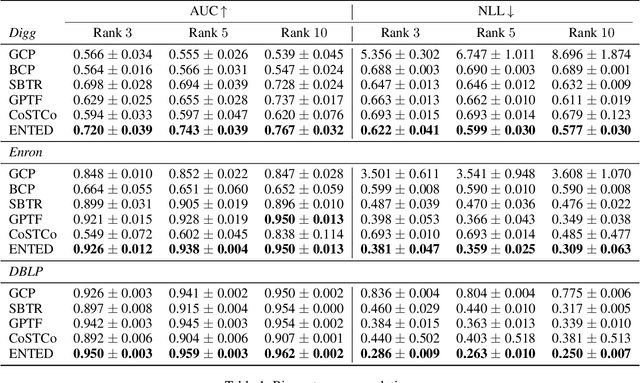

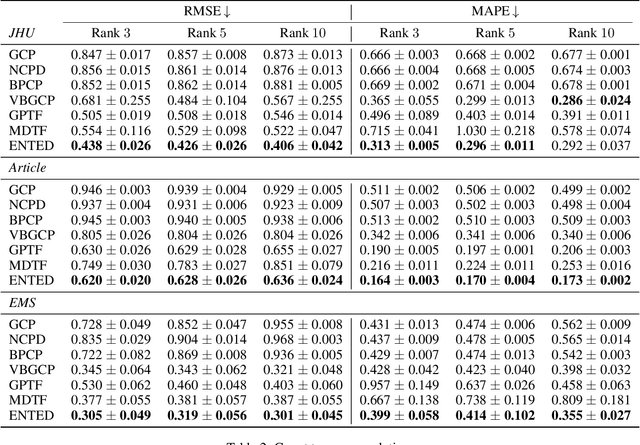

Abstract:In numerous applications, binary reactions or event counts are observed and stored within high-order tensors. Tensor decompositions (TDs) serve as a powerful tool to handle such high-dimensional and sparse data. However, many traditional TDs are explicitly or implicitly designed based on the Gaussian distribution, which is unsuitable for discrete data. Moreover, most TDs rely on predefined multi-linear structures, such as CP and Tucker formats. Therefore, they may not be effective enough to handle complex real-world datasets. To address these issues, we propose ENTED, an \underline{E}fficient \underline{N}onparametric \underline{TE}nsor \underline{D}ecomposition for binary and count tensors. Specifically, we first employ a nonparametric Gaussian process (GP) to replace traditional multi-linear structures. Next, we utilize the \pg augmentation which provides a unified framework to establish conjugate models for binary and count distributions. Finally, to address the computational issue of GPs, we enhance the model by incorporating sparse orthogonal variational inference of inducing points, which offers a more effective covariance approximation within GPs and stochastic natural gradient updates for nonparametric models. We evaluate our model on several real-world tensor completion tasks, considering binary and count datasets. The results manifest both better performance and computational advantages of the proposed model.
 Add to Chrome
Add to Chrome Add to Firefox
Add to Firefox Add to Edge
Add to Edge